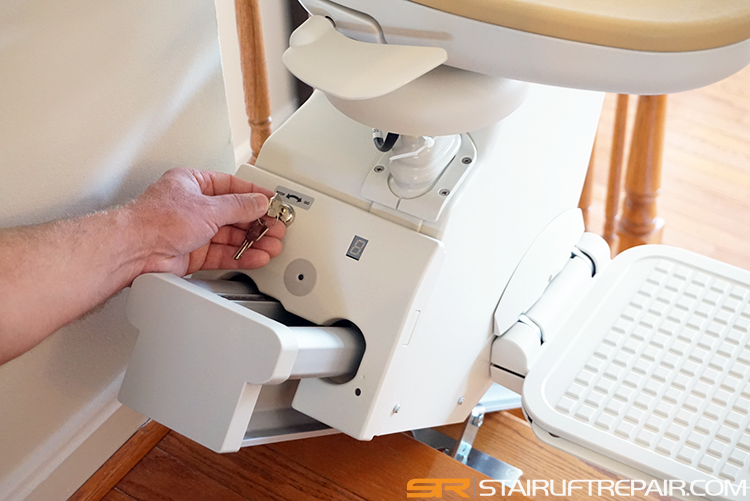Stairlifts are powered by rechargeable batteries that allow them to operate even during a power outage. These batteries rely on metal charging contacts located on the track where the stairlift picks up the charge voltage to stay charged and ready for use. When the chair touches these contacts they connect low voltage power from the charger or power supply to the batteries. Depending on the model these contacts can be in specific locations or anywhere on the track. Because stairlifts depend entirely on battery power for movement, clean and well-aligned charging contacts are extremely important. If the contacts become dirty, corroded, or misaligned, the batteries may fail to charge properly, eventually leading to complete loss of operation.
Each manufacturer designs these contacts a little differently. Acorn stairlifts uses precisely aligned charging points at the top and bottom of the track or in some cases a few feet up the track from the bottom landing when a folding rail is used. Harmar models feature contacts that are 3′ long, and Bruno lifts use contact strips along the full length of the track. These contacts may seem simple, but they play an important role in maintaining consistent power and preventing breakdowns. Keeping them clean, properly aligned, and free of corrosion helps the stairlift remains safe and ready to operate when needed.
Acorn Stairlifts
The Acorn 120, 130 and newer 130 T700 stairlifts use charging stations to recharge the internal batteries. The metal charging contacts on an Acorn Stairlift are 6 inches long and are positioned a few inches from the ends of the track. There are two charging contacts or stations, one at the top and one at the bottom. The contacts are made of two brass alloy strips seated in a plastic holder attached to the track with two screws. The charging stations will always be on the right hand side of the track, from the bottom of the stairs looking up.
The power cable is usually routed through one end of the track (preferably the top) and then internally to the other end of the track. In normal operating conditions the charge voltage should always be present at these stations for a continuous power supply. When these contacts appear dull, faded, or have minor oxidation they should be inspected and cleaned. One benefit to this type of charging contact is they are surface mounted and can be replaced easily if needed.

Harmar Pinnacle
The Harmar Pinnacle uses 36 inch long charging contacts mounted in the track. There are two charging contacts or stations, one at the top and one at the bottom. Each station will have a contact on the front and back side of the track for a negative and positive connection to charge the batteries. The power cable is routed internally in the track. What’s great about the length of these contacts is the lift doesn’t have to be parked exactly in the right spot to charge and if needed the lift can be moved off the charge points for cleaning and inspection. One drawback is the contacts are slotted into the sides of the track and can be harder to replace if ever damaged.

Bruno Contacts
The Bruno SRE 3000, 3050 and newer SRE 2010 stairlifts use full rail charging contact strips mounted on the back of the track. The strips are made of copper and should be checked on an annual basis. The power cable is routed externally to the track end junction point and does not need an internal cable because these copper contact strips carry the charge voltage to the other end of the track. The main benefit of full rail charge contacts is the chair can charge anywhere it’s parked on the track. However, because the lift is always in contact with these copper strips they can be harder to clean. The reason for this is not only that there’s more of an area to cover but DC voltage has to be removed from the charger and the lift before attempting to clean.

Whether you’re considering the purchase of a new lift or already own one, knowing how your model charges is a key part of proper maintenance and keeping your lift reliable. Understanding the charging system before purchasing is equally important, since it can affect where the lift can park, how often it needs to charge, and what kind of maintenance or cleaning will be required. Some systems charge only at specific points on the rail, while others can charge anywhere along the track, a difference that can influence both convenience and long-term battery life.



